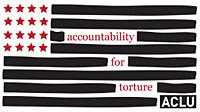The context of its release involves the Bush Administrations issuance of new interrogation guidelines to the CIA, guidelines that appear to allow the continued use of torture and cruel and degrading or inhumane treatment of government detainees in the "war on terror". The other major context concerns the ongoing battle to keep medical professionals from participating in coercive interrogations in illegal places of detention -- a battle that is being fought out most imminently in the listservs and council chambers of the American Psychological Association.
From the HRF/PHR Executive Summary (footnotes in text must be referenced through link):
All U.S. personnel who engage in the CIA's so-called "enhanced" interrogation techniques and similarly abusive techniques are at serious risk of violating U.S. law. Under U.S. law, as detailed below, the severity of physical pain or mental harm caused by an interrogation technique is key to determining whether the technique can be considered torture or cruel, inhuman or degrading treatment. An extensive body of medical literature, derived from the treatment and study of torture survivors worldwide, demonstrates that the "enhanced" techniques are likely to cause significant physical and mental harm to detainees. As a result, officials and interrogators who authorize and participate in interrogations using these techniques face a substantial risk of criminal liability under the provisions prohibiting "torture" and "cruel or inhuman treatment" in the U.S. War Crimes Act (WCA), as amended by the Military Commissions Act of 2006 (MCA),[1] and under The Torture Convention Implementation Act of 1994 (the Torture Act).[2] Many of these interrogation techniques may also be prohibited by the Detainee Treatment Act of 2005 (DTA).[3] To protect U.S. officials and personnel from potential criminal liability and to ensure that all U.S. personnel adhere to U.S. law, these techniques should not be authorized.The CIA "Enhanced" Interrogation Methods
On July 20, 2007, President George W. Bush issued an executive order interpreting the application of Common Article 3 of the Geneva Conventions to a program of detention and interrogation by the CIA.[4] The order does not clarify what techniques the CIA can and cannot lawfully engage in. Press accounts, citing anonymous Administration officials, suggest that at least one of the "enhanced" techniques, waterboarding, may no longer be used. The fact that the Administration officials may have ruled out some "enhanced" techniques, though, raises serious questions about whether the CIA guidelines implementing the Executive Order will permit Agency interrogators to resume the other techniques previously authorized.[5]
While the details of the CIA's "enhanced" interrogation program remain classified, credible reports have disclosed several of the techniques that were authorized in March 2002 for use in the program, including water-boarding (mock drowning), exposure to extreme cold (including induced hypothermia), stress positions, extreme sensory deprivation and overload, shaking, striking, prolonged sleep deprivation, and isolation, among others.[6] Without identifying specifically approved techniques, the President has, in the past, publicly endorsed "alternative interrogation methods," and declared that the MCA, which he signed into law in October 2006, allows the CIA "program" to continue.[7] The new executive order fails explicitly to rule out the use of the "enhanced" techniques that the CIA authorized in March 2002.
The Executive Order does state clearly that any program of detention and interrogation approved by the Director of Central Intelligence may not include any acts prohibited by the War Crimes Act or the Torture Act. Yet a close analysis of the War Crimes Act and other U.S. law, informed by medical and psychological expertise, reveals that these "enhanced" interrogation techniques, may constitute "torture" and/or "cruel or inhuman treatment" and, consequently, authorization of their use under the Executive Order would place interrogators at serious legal risk of prosecution for war crimes or other violations.
A recently declassified report by the Pentagon's Office of the Inspector General (OIG) revealed that these techniques were based in large part on techniques of torture and cruelty used by the U.S military in its Survival, Evasion, Resistance, and Escape (SERE) program. The SERE program was intended to train personnel to resist interrogation under such abuse if captured.[8] According to the OIG, these techniques were transformed, with the assistance of military psychologists, into "standard operating procedure" (SOP) for interrogations at the Guantánamo Bay detention facility. This Guantánamo SOP, the OIG reports, also was brought to Afghanistan and Iraq and, according to media reports, provided a basis for techniques used by CIA personnel, also with assistance from psychologists.[9] The origin of these techniques is directly related to the focus of this report. They were designed to inflict physical and psychological harm for the purpose of breaking down interrogation subjects. This report describes the nature and extent of that harm and the legal consequences to interrogators of employing techniques that cause it....
There must be no mistake about the brutality of the "enhanced interrogation methods" reportedly used by the CIA. Prolonged sleep deprivation, induced hypothermia, stress positions, shaking, sensory deprivation and overload, and water-boarding (which may still be authorized), among other reported techniques, can have a devastating impact on the victim's physical and mental health. [emphases added in bold]
Interested readers should go read the whole report.









No comments:
Post a Comment